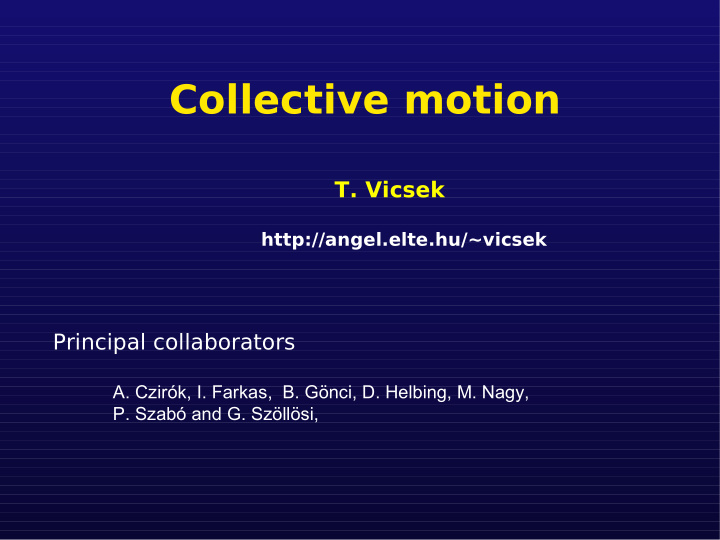



Collective motion T. Vicsek http://angel.elte.hu/~vicsek Principal collaborators A. Czirók, I. Farkas, B. Gönci, D. Helbing, M. Nagy, P. Szabó and G. Szöllösi,
Collective motion of
Collective motion of D. Winter BBC Massive nature
universal pattern of motion Locusts (Buhl, Sumpter, Couzin et al, Science , 2006)
3d J. Perrin, Microcosmos
Observation: complex units exhibit simple collective behaviours (the nature and “rules” of interactions are simpler than the units which produce them) Our goal: find the basic features/laws of collective motion
Swarms, flocks and herds • Model* : The particles i - maintain a given absolute value of the velocity v 0 - follow their neighbours - motion is perturbed by fluctuations η [ ] [ ] + = + η e ( t 1 ) E E e ( t ) ( t ) i j j ( E converts a direction into a unit vector) • Follow the neighbours rule is an abstract way to take into account interactions of very different possible origins • Result: ordering is due to motion * T.V, A. Czirok, E. Ben-Jacob and I. Cohen, PRL, 1995
Lessons: 1. Some patterns of motion are universal 2. Simple models can reproduce this behavior 3. A simple noise term can account for numerous complex deterministic factors 4. In many cases ordering is due to motion!
Continuous transition in the scalar noise model for small velocity Order parameter versus noise Probability distribution function of the order parameter for various noise levels Physica A, 2007 Jan. J. Phys. A 1997 M. Nagy, I. Daruka and T.V. A. Czirok, H. E. Stanley and T.V.
And in three dimensions? … very similar! v=0.1 v=0.5 “single humped” “double humped” i.e, second order i.e, first order transition transition Probability distribution of the order parameter
Visualizations of various 3d versions Scalar noise Scalar noise model (1995 PRL Vicsek et al model) High velocity (v=3.0) Low velocity (v=0.1) (motivated by 2004 PRL Gregoire, Chate)
Visualizations of various 3d versions Reynolds-type models More “realistic” model More “realistic” model ( with repulsion + attraction Reynolds, Couzin and others) In a cylinder Periodic boundary conditions More “realistic” model Birds’ view
Visualizations of various 3d versions Flocking with turning Stereo view Collective turning is introduced through coupling of the acceleration of the particles Weak coupling (close to ’95 PRL scalar noise model) Regular view Stereo view Yet another stereo view “Critical” coupling (new model) Regular view Stereo view
A further lession: Apparently during evolution the “parameters” of birds are “tuned” to values keeping a flock close to a “critical state” (to a state with large fluctuations) such as the aerial displays of starlings Such a state seems to be optimal for the propagation of information which is useful from the points of - exploration - collective decision making
Collective motion of keratocites Relevance: - Wound healing - Tissue engineering - Embriogenesis We obtain skin cells from scales of gold fish kept in the lab
Experiment, i.e., we can control density Velocities from tracking Order parameter
Modelling the group motion of keratocites Qualitatively new feature: the velocities of the neighbours are not part of the equations The preferred direction of motion of a cell is approaching the actual direction with a rate τ . Actual direction is given by: preferred direction plus “pushing” by other cells
Disorder-order phase transition as a function of density ( ρ ) perturbations ( η )
Group motion in confined geometry Along adhesive strips In a rectangular pool
Group motion of humans (theory) Model: - Newton’s equations of motion - Forces are of social, psychological or physical origin (herding, avoidance, friction, etc) Statement : - Realistic models useful for interpretation of practical situations and applications can be constructed
EQUATION OF MOTION for the velocity of pedestrian i − 0 0 d v v ( t ) e ( t ) v ( t ) ∑ = + + m i m i i i f f , i i ij iW τ dt ≠ j i i [ [ ] ] ( ) ( ) ( ) = − + − + κ − ∆ t f A exp r d B kg r d n g r d v t , ij i ij ij i ij ij ij ij ij ji ij “psychological / social”, elastic repulsion and sliding friction force terms, and g(x) is zero, if d ij > r ij , otherwise it is equal to x. MASS BEHAVIOUR: “herding” [ ] , ( ) + = − + 0 e ( t 1 ) N 1 p e ( t ) p e ( t ) i i i i j j = where N ( z ) z z denotes normalizat ion of z .
Panic • Escaping from a closed area through a door • At the exit physical forces are dominant ! Nature, 407 (2000) 487
The “impatience or anxiety factor” N=3000 N after 50 sec “patient” 95 “impatient” 2
Comparing bird and human soaring strategies Zs. Ákos, M. Nagy and T. Vicsek Dept. of Biological Physics, Eötvös University, Hungary http://angel.elte.hu/~vicsek http://angel.elte.hu/thermalling Zs. Á, M. N., T. V.: PNAS , 2008
The art of soaring Birds of pray, large migrating birds, human gliders all do it
Collecting data Lightweight GPS Resolution: 1m, 1sec
Tracks: Falcon paraglider
The MacCready theory (principle) p(v xy ) – polar curve
Comparison with the predictions of the theory Upper black lines: optimal strategy for the given polar curves Blue dots: measured horizontal gliding velocities for the given climb rates
http://angel.elte.hu/~vicsek
Recommend
More recommend